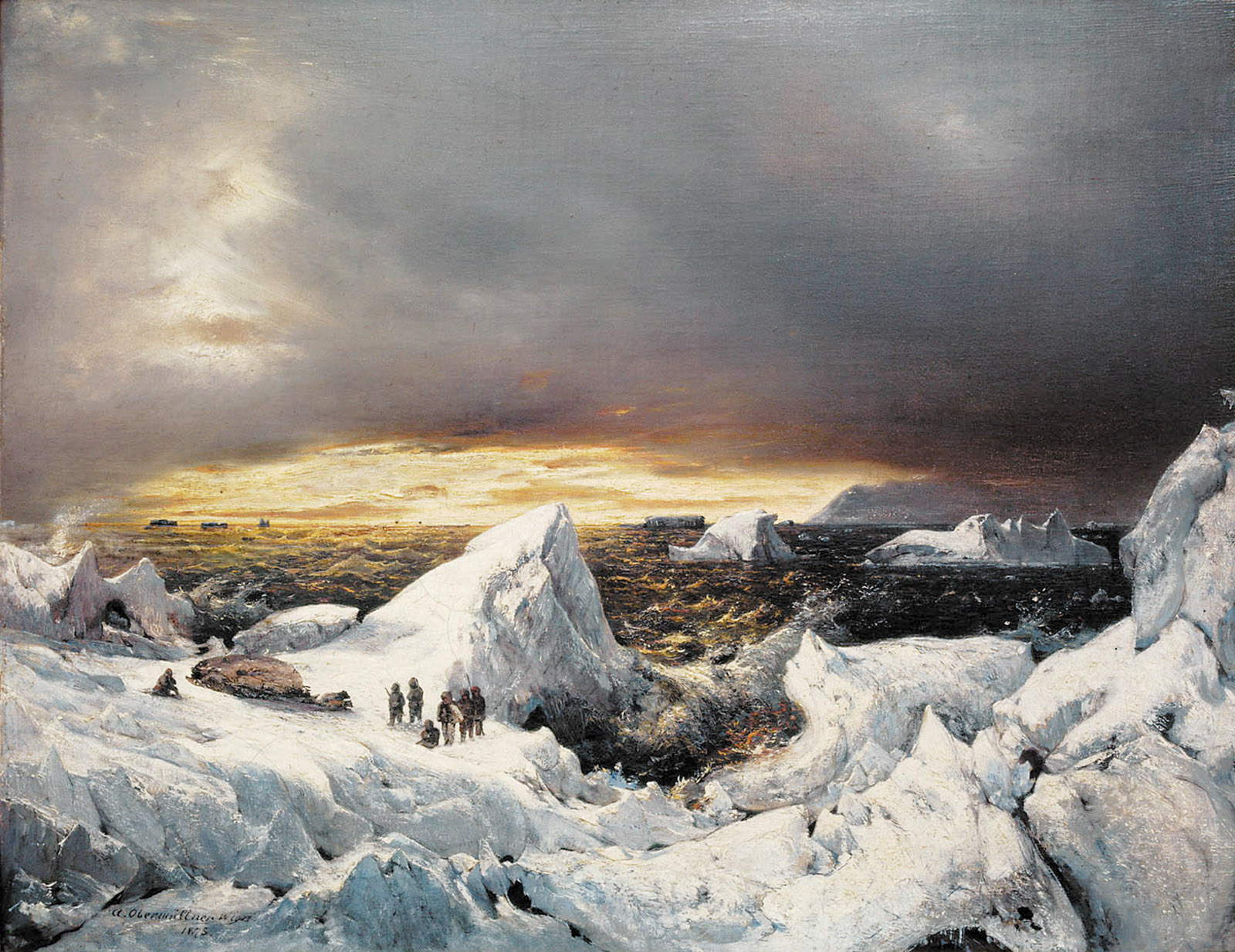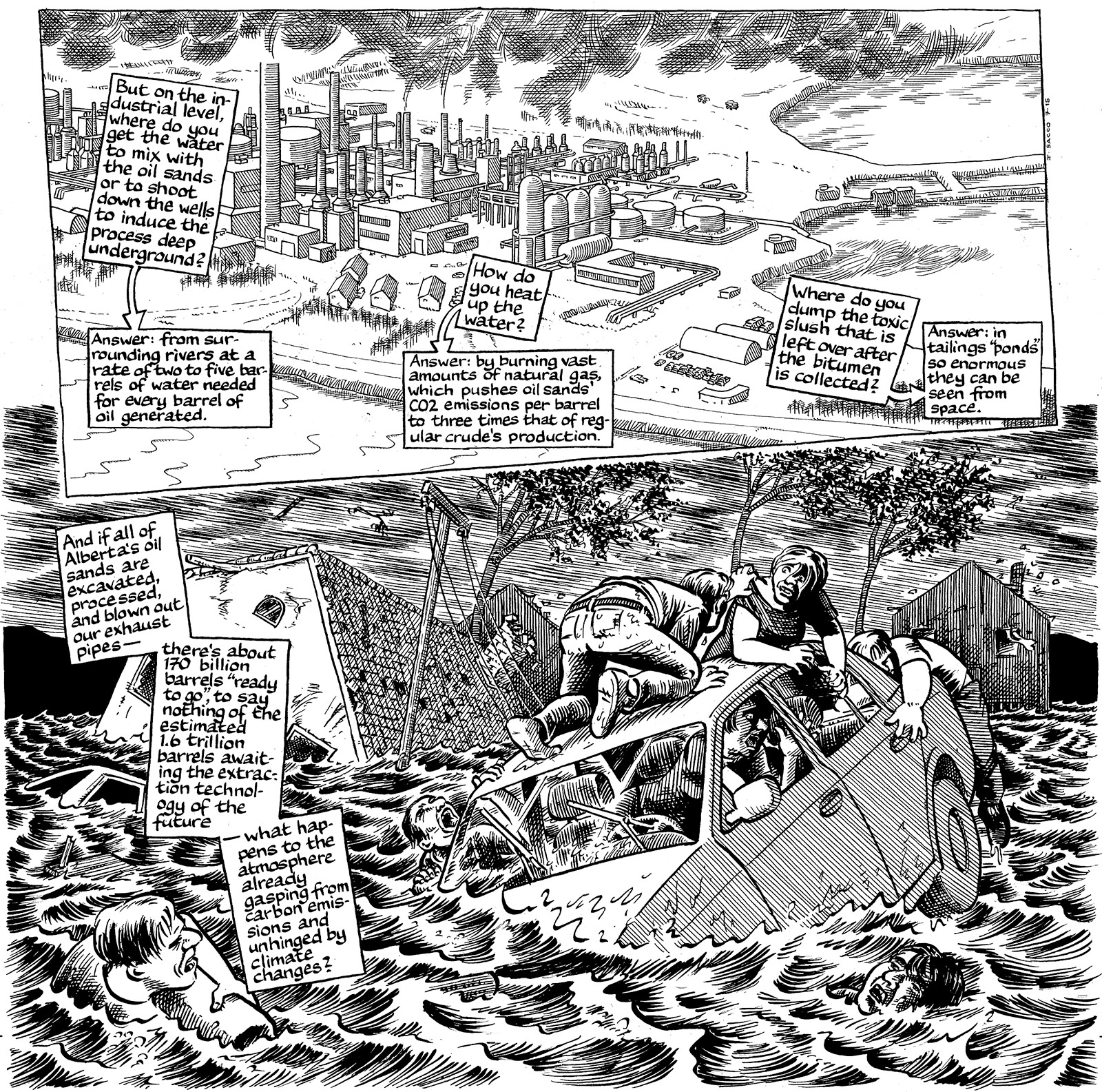At the opening of the United Nations climate change conference in Poland in December, UN Secretary-General António Guterres made a short speech with a long history. The twenty warmest years on record, he said, have occurred in the past twenty-two years, with the past four years the four warmest; the concentration of carbon dioxide in the atmosphere is the highest it has been in three million years; greenhouse gas emissions, after leveling off for the past three years, are once again on the rise, a trend led by China, the United States, and India. “We are in trouble. We are in deep trouble with climate change,” Guterres said. “Science demands a significantly more ambitious response.”
Such warnings have become so familiar that it is easy to lose sight not only of their significance, but also of the enormous effort behind each deceptively simple statement. In order to know that the planet has recently experienced the twenty warmest years on record, generations of scientists have had to measure temperatures precisely enough, frequently enough, and widely enough to distinguish a long-term global trend from the roar of short-term and local variations. In order to know that the concentration of atmospheric carbon dioxide is the highest it has been in three million years, scientists have analyzed the content of tiny air pockets trapped in ancient Antarctic ice and counted the number of microscopic stomata—portals for the intake of carbon dioxide—on the surface of fossilized leaves. In order to understand how humanity is changing the climate today and is likely to change it in the future, scientists have tracked interactions among phenomena at vastly different scales, from the molecular to the oceanic, and discerned how those interactions change over both time and space.
When the work of climate science began, in the seventeenth and eighteenth centuries, most Europeans accepted the Aristotelian model of a static global climate, a kind of spherical shell sectioned latitudinally into fixed temperature zones. The modern concept of climate as a dynamic system of air and ocean currents lay far in the future, as did the understanding that human activities could destabilize that system. The earliest climate scientists had no satellites to collect data and no computers to analyze them; they intuited that there was a story to be told about the atmosphere’s influences on Earth, and that this story could be found through the accumulation of careful measurements. As historian Deborah Coen recounts in her book Climate in Motion, this imaginative leap was a product of a particular time and place.
In 1526, when the Hungarian monarch Louis II was defeated and killed by the Ottoman forces of Suleiman the Magnificent at the Battle of Mohács, the crowns of Hungary and Bohemia—and the nominal control of a vast area of Central Europe—abruptly passed to the junior branch of the Habsburg family. While its authority over this collection of kingdoms, duchies, and principalities was tenuous and frequently challenged, the family managed to retain and expand its holdings, and by the nineteenth century it ruled more than 430,000 contiguous square miles, an area nearly twice that of modern Germany.
Bordered by the Alps and the Carpathian Mountains, divided by the Danube River and its tributaries, and mostly too high and cold for agriculture, the territory was nonetheless, as Coen writes, “good to think with.” Stretching across nine degrees of longitude, from the western tip of modern Austria to the middle of modern Romania, it was a representative sample of the planet that allowed its scientists to collect information of both local importance and global relevance: observations of alpine glaciers in the Habsburg lands, for instance, enabled geographers to draw general conclusions about the European climate during the Ice Age.
Habsburg scientists also benefited from the political philosophy of their patrons. Instead of trying to obscure or subdue regional differences within their territory, the Habsburgs strove for what they called “unity in diversity,” seeking to create not homogeneity but a shared pride in the empire’s many cultures, species, and landscapes. “Austria’s strength rests on the diversity of its provinces,” Archduke Johann wrote in 1817. To this end, Habsburg emperors assembled elaborate cabinets of wonders to showcase the natural and cultural riches of their territory; explorers under their patronage brought back gemstones from Bohemia and Moravia, mushrooms from Hungary, and plant and animal specimens from throughout the empire. In the 1500s, Emperor Rudolf II recruited a team of naturalists to expand his collection, devoting an entire wing of his castle in Prague to what was essentially a research museum.
For the Habsburgs, the climatic diversity of their territory had added significance. They wanted to better understand floods, famines, and other extreme events that could disrupt societies and economies, creating sudden and serious threats to their rule. During a time when learned Europeans relied on accepted first principles to explain natural phenomena, prizing theory over observation, the Habsburg emperors had a vital interest in observation—in extremes as well as averages, local peculiarities as well as general patterns. For Habsburg climate scientists, then, nothing was too small to notice or too grand to attempt: some used floral surveys as “a vegetable thermometer” to measure variations in temperature across time and elevation, much as scientists today use long-term botanical records to track the effects of climate change on the flowering times of plant species. Others went up in hot-air balloons to study wind patterns, assembling a three-dimensional map of air flow over the Alps and learning—from unnerving firsthand experience—to distinguish between local gusts and further-reaching air currents.
Advertisement
The Austro-Hungarian Empire was described by both admirers and critics as a political “laboratory” or “experiment,” and for the climate scientists it sponsored, the laboratory was literal as well as metaphorical. The empire was a rich source of data, and the data, over time, would suggest new theories. “Everywhere there is a macrocosm and a microcosm,” wrote the Austrian astronomer and geographer Karl Kreil, “a world on the large scale and on the small—the latter just as important, often more important than the former.”
In 1851 Emperor Franz Joseph established the Central Institute for Meteorology and Geomagnetism (ZAMG) in Vienna, installing Kreil as its first director. The institute—the oldest weather service in the world—was, like other meteorological offices of its time, expected to issue weather forecasts and warnings. While Kreil and his colleagues did help to develop an international storm-warning system, they pointed out that their science was much better equipped to characterize long-term patterns than to make short-term forecasts—and that an understanding of long-term climate trends would ultimately be more useful to farmers, commercial traders, medical professionals, and others. From the sea of numbers amassed by generations of Habsburg scientists, ZAMG researchers drew increasingly fine-scaled maps of temperature, precipitation, and elevation across the empire, interpreting their data for the benefit of their multiple constituencies.
Fifteen years after the founding of the ZAMG, Kreil’s grandson-in-law Julius Hann, a young institute researcher familiar with the new science of thermodynamics, recognized that atmospheric pressure was a crucial determinant of local climate. Assembling the three decades of carefully calibrated barometric measurements collected at Habsburg weather stations, Hann conducted a painstaking analysis, sometimes spending a week or more deciding whether to adjust a certain location’s average pressure by a tenth of a millimeter up or down. “Many may well wonder if it is even worthy of a serious man to devote so much time and effort to such a minor result,” he acknowledged.
Such careful attention to small variations, however, allowed him to accurately map the distribution of atmospheric pressure across Central and Southeast Europe, which in turn allowed him to understand local storms not as isolated occurrences but as tiny gears in the global machinery of atmospheric circulation. This insight transformed the field of climate science: it finally overturned the static Aristotelian model of the climate, enabling the first studies of global climate dynamics and, eventually, the construction of today’s high-powered computer models of past and future climates—models that aim, as Hann did, to produce a “maximally life-like picture” of the atmosphere.
The discipline of what came to be called dynamic climatology also changed the way that ordinary people saw their world. For the first time, Austrian citizens learned that their local weather was not determined by fixed climate zones but resulted from interacting global phenomena. By the late 1800s, there were nearly 450 weather stations in the ZAMG network, many staffed by teachers, physicians, innkeepers, telegraph operators, and other volunteers curious about what they perceived as newly unsettled surroundings. The new science, Coen writes, invited regular people “to imagine their relationship to the territory of the empire in dynamic terms…as a contingent, and potentially turbulent, circulation.”
During World War I, the Habsburg tradition of climate science was co-opted by German nationalists, who distorted its findings to suggest that cultural differences could be mapped like barometric readings of air pressure. But as Coen writes, this was a temporary shift in an inherently pluralistic field. In the century since the collapse of the empire, climate science has become an international enterprise, sharing data across boundaries in an ongoing effort to uncover and refine the story of global change. By necessity and inclination, it is as complex and dynamic as the system it seeks to understand.
As Coen points out, climate science is essentially a process of scaling—of “mediating between different systems of measurement, formal and informal, designed to apply to different slices of the phenomenal world, in order to arrive at a common standard of proportionality.” Scaling, she emphasizes, is inherently uncertain and imperfect, for no measurement is absolute, and any analysis of multiple measurements at multiple scales requires interpretation. Julius Hann turned a set of barometric readings taken at specific points over time into a continental-scale map of air pressure; modern climate scientists use a web of individual weather stations to construct computer models of the global climate system. Both efforts connect the microcosm with the macrocosm—what Kreil called “the world on the large scale and on the small.”
Advertisement
“In the nineteenth century,” Coen writes, “the scalar imagination was restless”—new and newly precise microscopes, telescopes, cameras, and clocks brought both the very small and the very large into view, changing peoples’ perceptions of themselves and their relationship with the world around them. These developments, Coen finds, affected not only the era’s science but also its art and literature: Victorian novelists such as George Eliot and Thomas Hardy, who were familiar with the astronomical discoveries of their time, used shifting perspectives and complex plots to suggest worlds in constant motion; landscape painters elaborated grand horizons with new levels of detail.
While scaling is part of any scientific or artistic endeavor, it is also, as Coen writes, “something we all do every day,” whether we’re comparing the price of bulk rice with that of packaged rice or comparing the enormous scale of the changes described by Secretary-General António Guterres with the tiny scale of our own individual influence. In this general sense, certainly, our own time is at least as restless as the nineteenth century, and popular writing about climate change reflects that dislocation—though most tends to dwell on the size of the problem while exhorting its readers to individual consumer and citizen action, inevitably if unwittingly emphasizing the difference in scale.
One recent exception is Global Warming and the Sweetness of Life: A Tar Sands Tale, a slim, oddball travelogue written by Matt Hern and Am Johal and illustrated by the cartoonist Joe Sacco. Hern and Johal, who are both from Vancouver, British Columbia, are community organizers fluent in the -isms of leftist political analysis, but as narrators they are appealingly humble and refreshingly determined to talk about big ideas with the individuals who would be most affected by their implementation.
They begin by proposing that any lasting solution to climate change requires a transformation of the relationship between humans and land—by which they mean less emphasis on “development” as an uncontested good, and more emphasis on the quality of both human and nonhuman lives. They road-test this vague proposition in the oil sands of northern Alberta, where the energy-intensive extraction of oil from underground deposits is, by most scientific estimates, well on its way to busting the planetary carbon budget. While Hern and Johal find an industrial hellscape there, they also find the city of Fort McMurray, where people from Nova Scotia to the Philippines are not only working themselves out of debt by driving trucks or tending bar but also finding genuine fulfillment. “This isn’t a boomtown, it’s a hometown,” says Reinalie Jorolan, a labor organizer.
Fort Mac is both, of course, as the landscape around it is both ancestral First Nations territory and a fossil-fuel sacrifice zone. Instead of accepting that development—and climate instability—is a precondition of prosperity, Hern and Johal ask, what if Canada were to prioritize hometown over boomtown, First Nations territory over sacrifice zone? Hern and Johal point approvingly to Ecuador’s 2007 Yasuni-YTT initiative, in which the government of President Rafael Correa promised to suspend oil drilling in Yasuni National Park if the international community compensated the country for about half the estimated revenue from it—money that would have then been invested in clean-energy development and indigenous land protection? The initiative failed, but it brought attention to the true costs of both extraction and conservation, and who pays the bill for each. The larger point of Hern and Johal’s discursive journey is that long-term solutions to climate change probably won’t be measured in familiar units. They may well require new scales—and imaginative leaps as large as those once taken by the scientists of the Habsburg Empire, who wondered if a climate nearly everyone believed to be static was in fact in perpetual motion.
While Hern and Johal, along with their various interlocutors, wrestle with the meaning of their participation in the fossil-fuel economy, Deborah Coen illuminates both the emotional and intellectual lives of her subjects. Climate in Motion pays close and welcome attention to the human experience of trying to understand the global climate—a job that was as daunting in nineteenth-century Austria as it is in twenty-first-century Alberta. The Habsburg scientists struggled to situate their detailed data in unfamiliarly vast settings. “Charged with distinguishing between things that were small yet significant, and those that were truly petty,” Coen writes, “these scientists became tormented by their liability to be distracted by irrelevant details or merely personal concerns.”
The Habsburg scientists expressed this inner turmoil in their letters to friends and family, writing of homesickness, confusion, and self-doubt. Julius Hann, like Karl Kreil, was educated in the alpine foothills at the Kremsmünster abbey school, whose Benedictine monks expressed their devotion by observing creation in detail. Hann privately longed for the monastery’s peaceful seclusion during his later life. “Take me back to you, forests; your peace, your mercy to a tormented, wounded heart,” he wrote in his journal in 1869, when he was thirty. Hann continued his public career as a renowned scientist, but he was clearly torn between the local and the global, the small and the large.
These are hidden, nearly invisible currents, discovered by Coen in almost illegible letters and diaries. But they are a powerful reminder that understanding rarely comes quickly or easily, especially when the mysteries are both larger and smaller than previously imagined. Judgments about the relationship of human actions to planetary currents “have not derived from a unique perceptual faculty, nor from personal wisdom,” Coen writes. They are, she says, “the result of a process”—a process of calibration and reorientation that unsettles both mind and heart, and never ends.




